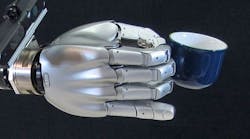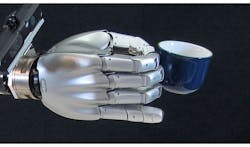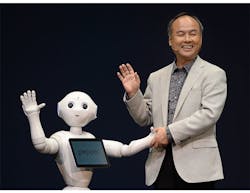Doing the dishes isn’t the most scintillating of chores, so a robot that picks up your crockery and glassware safely could prove a huge success in the kitchen. Boris the robot could be the future answer. And while Boris loads the dishwasher, his robotic colleague Bob could be taking a look around your house to make sure everything is safe and secure. These are two robotic innovations developed by the University of Birmingham in the UK.
Boris can identify plates, pans, cutlery, and cups using sensors on his wrists and face, then work out how to most efficiently pick up each different shape. With five fingers on his hands, Boris picks things up like a human (Fig. 1). Research engineer Maxine Adjigble said he has been trained to pick up objects in a certain way, depending on their properties, so that fragile objects won’t get smashed.
But programming of Boris isn’t just to pick up these objects, but also to learn how to pick them up. Professor Jeremy Wyatt, University of Birmingham School of Computer Science, explains: "The idea is to get the robot to load your dishwasher. You get a bunch of objects off a table, scattered as you might have them on a kitchen surface, and the robot will look through the set of objects, find one it wants to pick up, figure out where to put it in the dishwasher, and load it."
Working with People
Boris is part of a third generation of robots built and programmed to work with people, and be able to cope with the diverse and complicated environments created by humans.
The robot can view objects with depth sensors on his head and wrists. Then, in seconds, he can calculate a pattern of arm movements, up to a thousand different ways to pick up an object using his five fingers, and determine a route to reach his end goal. And it must be done without bumping into obstacles like surrounding furniture.
Boris’ sophistication classifies it as a third-generation robot. Broadly speaking, first-generation robots are programmed to perform repetitive tasks in a controlled environment. Industrial assembly robots are a prime example. Second-generation droids include airborne drones, self-driving cars, and other mobile robots. Third-generation robots, on the other hand, have to do some thinking and decision-making to cope with more complicated tasks in an uncontrolled environment.
At the moment, researchers are still working on introducing second-generation systems, which include self-driving cars like that being prototyped by Google, and drones such as those Amazon hopes will deliver its prime goods at some point in the future.
So while Boris is tidying the kitchen, what's Bob up to?
Robot Security Officer
Bob already has a job with security company G4S, working as a trainee security officer with that company on a three-week trial. He will perform tasks that include patrolling the offices, monitoring the environment, checking doors are closed, and that desks are clear. It’s claimed to be the first time an autonomous robot has been employed in such a role within a working office environment.
The University of Birmingham’s research team developed the software that enables Bob to process all the information he needs to map and navigate his environment. Using cameras and scanners as his eyes (Fig. 2), he can create a map of his surrounding area, identifying desks, chairs, and other objects that he must negotiate when moving around, as well as detecting people’s movement through activity recognition.
While Bob carries out his duties, he will also gather information about his surroundings and learn about how the environment changes over time. These “changes” include where people go, where objects appear, and whether fire doors are open or closed. And if Bob finds the work tiring, he knows when to trundle off to his docking station to charge up the batteries.
Bob is part of the £7.2 million STRANDS project. This involves robots learning how to act intelligently and independently in real-world environments, supporting security officers or care home assistants, while understanding 3D space and how it changes over time from milliseconds to months.
Dr Nick Hawes, leader of the STRANDS project from the School of Computer Science at the University of Birmingham, said: “We wanted to build an autonomous intelligent robot that can be put into a real-world scenario like a place of work.”
But Boris and Bob are not the only potential third-generation robotic stars.
There is Werner, who works in a care home in Vienna, Austria. He spends his time playing simple games with residents. This may seem like an unusual application, but not so when looking at other developments.
According to Japanese technology company SoftBank, it plans to market a robot that’s capable of understanding human emotions. Developed by French robotics firm Aldebaran, and manufactured by Taiwan's Hon Hai Precision Industry Company, Pepper the robot stands about three feet tall and has a tablet computer attached to its chest (Fig. 3). It’s expected to go on sale next year, and one of its competencies will be looking after the elderly.
Some of you may think this is a risky financial venture for the company. However, about 22% of Japan’s population is aged 65 years or older, it’s one of many companies working on robots that can assist the elderly. In a recent report, analyst MarketsandMarkets predicted that the service robots sector will be worth €15 billion by 2020.
Indeed, Boris and Bob could be looking at a very rosy future.



